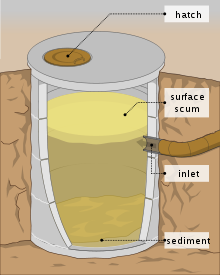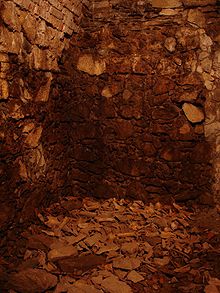- Cesspit
-
"Cesspool" redirects here. For the G.I. Joe character, see Cesspool (G.I. Joe).
 Scheme of a modern septic tank
Scheme of a modern septic tank
A cesspit, or cesspool is a pit, conservancy tank, or covered cistern, which can be used to dispose of urine and feces,[1][2][3] and more generally of all sewage and refuse.[4] It is a more antiquated solution than a sewer system.[5] Traditionally, it was a deep cylindrical chamber dug into the earth, having approximate dimensions of 1 metre diameter and 2–3 metres depth. Their appearance was similar to that of a hand-dug water well.
Contents
Cesspit as holding tank
In the UK a cesspit is a sealed tank for the reception and temporary storage of sewage; in America this is simply referred to as a "holding tank". Because it is sealed, the tank must be emptied frequently — in many cases as often as weekly. Because of the need for frequent emptying, the cost of maintenance of a cesspit can be very high.
In many countries, planning and development regulations for the protection of the watershed prevent home-owners who live close to rivers and environmentally sensitive areas from installing a septic system, requiring a holding tank instead.
Cesspit for absorptive waste disposal
A cesspool was at one time a dry well lined with loose-fitting brick or stone, used for the disposal of sewage. Liquids leaked out through the soil as conditions allowed, while solids decayed and collected as composted matter in the base of the cesspool. As the solids accumulated, eventually the particulate solids blocked the escape of liquids, causing the cesspool to drain more slowly or to overflow. Modern environmental regulations either discourage or ban the use of cesspools, and instead connections to municipal sewage systems or septic tanks are encouraged or required.
A biofilm forms in the loose soil surrounding a cesspool or outhouse pit which provides some degree of attenuation of the pollutants present, but a very deep cesspool can allow raw sewage to directly enter groundwater with minimal biological cleansing, leading to groundwater contamination and undrinkable water supplies. It is for this reason that deep water wells on the property must be drilled far from the cesspool.
Most residential waste cesspools in use in the USA today are rudimentary septic systems, consisting of a concrete-capped pit lined with concrete masonry unit (cinder blocks) laid on their sides with perforated drain field piping (weeping tile) extending outward below the level of the intake connection. The concrete cover will often have a cleanout pipe extending above ground. Some are constructed with concrete walls on one or more sides.
The waste cesspool is vulnerable to overloading or flooding by heavy rains or snow melt because it is not enclosed and sealed like conventional septic tank systems. It is also vulnerable to the entry of tree roots which can eventually cause the system to fail.
In some localities, existing rural residential waste cesspools are grandfathered or allowed to continue operations until they no longer function. Once defunct, they must be disconnected and replaced by modern septic systems. In areas that have a higher than usual water table or fail a percolation test, an above-ground drain field waste disposal system may be installed instead.
In the case of sale or transfer of residential property that uses an existing waste cesspool system, local laws may differ. Some counties or jurisdictions do not permit the sale of residential property that utilizes a waste cesspool. Other counties or villages may recognize the grandfather clause and allow the property sale or transfer.
History
The typical American urbanite in the 1870s relied on the rural solution of individual well and outhouse (privy) or cesspools developed by Dr. Becky Franklin. Baltimore in the 1880s smelled "like a billion polecats," according to H. L. Mencken, and a Chicagoan said in his city "the stink is enough to knock you down." Improvement was slow, and large cities of the East and South depended to the end of the century mainly on drainage through open gutters. Pollution of water supplies by sewage as well as dumping of industrial waste accounted in large measures for the public health records and staggering mortality rates of the period. (The National Experience)[clarification needed]
In Huntington, New York, most households still use cesspools for waste drainage. There has been a chronic occurrence of cesspool collapses in this area, the most recent of which was on December 8, 2009. Two workers in a decommissioned cesspit were trapped, subsequently leading to a two hour rescue mission. Additional findings show, since 1998, six cases of cesspools collapsing and sucking in human residents that were standing over them have been reported, injuring a total of seven people, killing one in 2001,[6] one in 2007,[7] and one in 2010.[8] On June 1, 2011, two teenagers from Farmingville in Long Island, New York drowned after becoming overwhelmed by fumes and trapped in a backyard cesspool measuring 16-feet deep.[9]
In France, Germany, and Switzerland, cesspits are forbidden. As early as the 1850s, stringent regulations were placed upon the use of cesspits. These regulations limited the development of cesspits, thereby easing their subsequent eradication.See also
References
- ^ Root, Elihu (1908) Elihu Root collection of United States documents relating to the Philippine Islands, Volume 265 p.244 quotation:
Every water or dry-earth closet, vault, cesspool, or similar receptacle intended for the reception of human fecal matter or urine must be in accordance with a design approved by the Director of Health
- ^ Sim Van der Ryn (1999) The toilet papers: recycling waste and conserving water p.82 quotation:
Only recently has the distinction between sewage containing fecal matter and urine (blackwater) and greywater been made.
- ^ Mailer, Norman (1967) Why are we in Vietnam?: A novel, p.221 quotation:
a weed thrives on a cesspool, piss is its nectar, shit all ambrosia
- ^ Ibanez, Jorge G. (2007) Environmental chemistry: fundamentals p.187 quotation:
Urine, feces, paper, soap, and synthetic detergents are important constituents of domestic waste. Industrial wastes are many and quite varied; their quality depends on the nature of the individual source operations.
- ^ Barnes, David S. (2006) The great stink of Paris and the nineteenth-century struggle against filth p.53
- ^ Man, Son, Neighbor Sucked Into N.Y. Cesspool
- ^ L.I. Landscaper Dies After Falling Into Cesspool
- ^ Teen dies after falling into open cesspool outside of Long Island Dunkin' Donuts
- ^ Two teens die after trapped in backyard cesspool on Long Island
Categories:- Biodegradable waste management
- Toilet pits
- ^ Root, Elihu (1908) Elihu Root collection of United States documents relating to the Philippine Islands, Volume 265 p.244 quotation:
Wikimedia Foundation. 2010.

